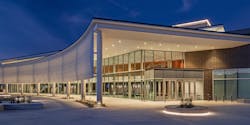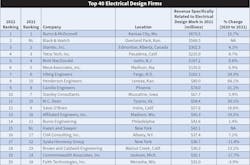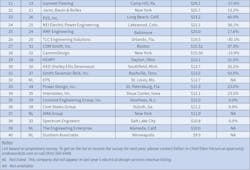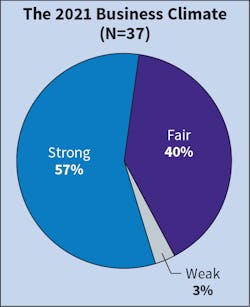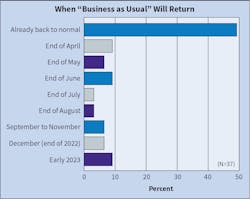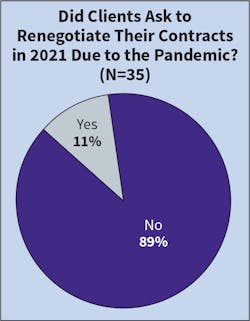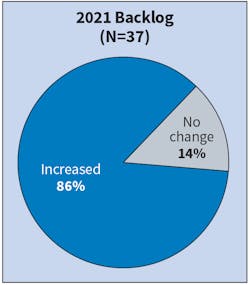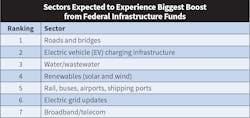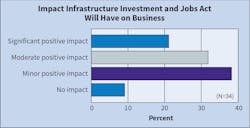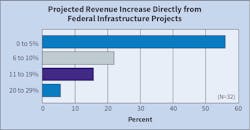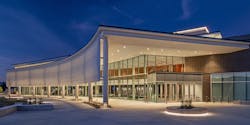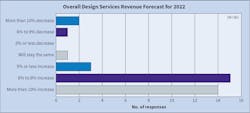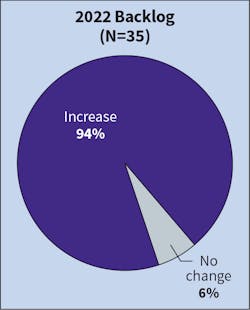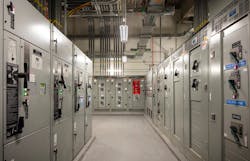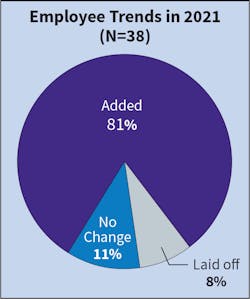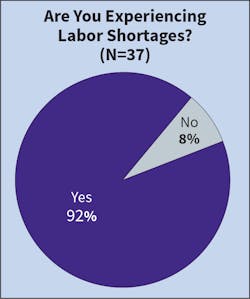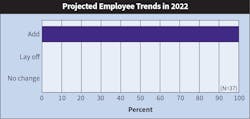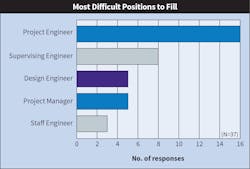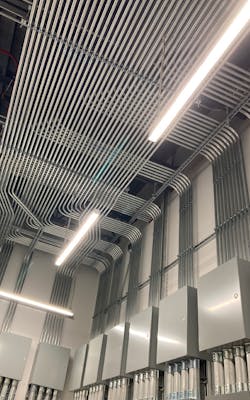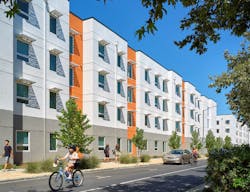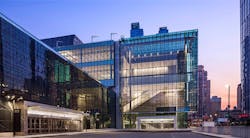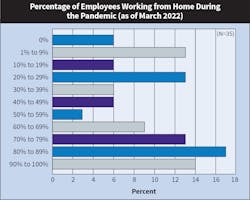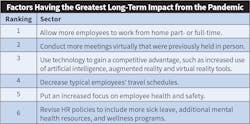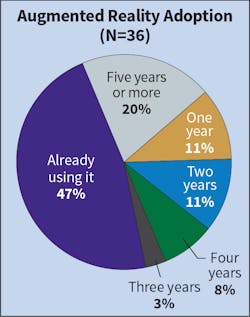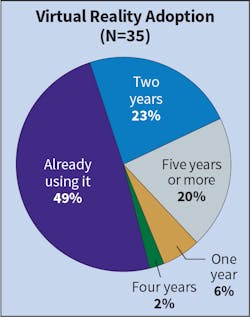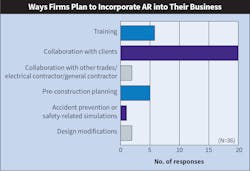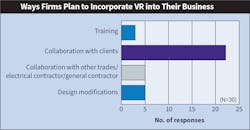What Pandemic? EC&M’s 2022 Top 40 Electrical Design Firms Special Report
Patience and persistence were rewarded in much of the business world in 2021. As the economy began to rebound from the shock of the COVID-19 pandemic felt so acutely in 2020, survivors began picking up the pieces. Searching for a return to normal, commerce got back on track in 2021, picking up smartly mid-year as signs of a pandemic “all clear” began to slowly emerge, albeit in the encroaching shadow of surging inflation and other worrisome economic signals.
Whether that unprecedented jump is skewed by other revenue-reporting anomalies or not, design firms clearly had a strong year on the revenue side, booking sales from earlier projects and drawing income from new work. More telling, characterizations of the year and specifics on performance and business condition metrics (revealed in responses to questions on the EC&M Top 40 Electrical Design Firms survey) suggest firms are largely recovering, and, despite cautionary signs, taking a growth-oriented stance.
Bouncing back
Helping feed that change in assessment were the raw numbers. Forty-three percent said they exceeded electrical design revenue expectations in 2021 (Fig. 4), while only 8% did not. That’s a big turnaround from last year, when just 35% said revenues came in as expected in 2020, and a near equal percentage said revenues fell short. Of 34 firms making a repeat appearance, 26 reported revenue gains over 2020. Another key metric, backlog accumulation, also reversed. Eighty-six percent said it increased (Fig. 5), up from 51% the year before. None said it decreased; 41% had said backlog dipped in 2020.
“Our growth has usually been in the high single digits year to year, so this higher rate was partly a reflection of slower growth we saw in 2020,” says John Olander, chief operating officer. “After a lot of projects were cancelled in 2020, clients were ready to get back on track.”
Water project specialist Carollo Engineers, Inc. (No. 9), Phoenix, staged a big turnaround from 2020, when its electrical/instrumentation/control revenue fell 4%. It rebounded last year, ending 31% higher, as mothballed projects restarted, and demand for getting critical new projects out of the gate surged.
“Many of our clients had pulled bonds on projects, and master plans/dollars were set and ready to go,” says Ron Burdick, instrumentation engineer. “It was definitely a strong year for us.”
An infrastructure tilt
Demand for such critical infrastructure work, broadly defined, buoyed the fortunes of many design firms in 2021. Conversely, with the pandemic having disrupted social patterns, demand for projects loosely categorized as those oriented to bringing people together has been slow to rebound — and could potentially be impaired long term. Consequently, designers’ future performance may hinge on their level of expertise and experience in “hot” markets, coupled with their ability to be nimble.
At Syska Hennessy Group (No. 17), New York, big infrastructure-oriented projects continued to generate more income, and only the tip of the demand iceberg has been seen, predicts Cyrus Izzo, co-president/chief executive officer.
The work profile of Harley, Ellis, Devereaux (No. 30), Southfield, Mich., continued to shift in 2021. HED Associate Principal/Engineering Practice Lead Kenneth Golovko says private office projects receded as remote work took hold, and building space was repurposed. But there was an upswing in health-care-related work and laboratory spaces, which can have intense and specialized electrical requirements. There’s also been a steady uptick, he says, in demand for mission-critical project design work, notably data centers.
The Engineering Enterprise (No. 39), Alameda, Calif., saw broad-based demand for its electrical-exclusive design services last year, says Principal Scott Wheeler.
“There’s a lot of higher education and K-12 work, which we don’t see slowing down,” Wheeler noted. “We had a steady amount of work based on being very diverse in many markets, except retail and hospitality. One market that has cooled down is transportation, but it’s one that might come back pretty rapidly at some point.”
An EV boon?
Matt Goss, senior vice president and MEP/energy practice leader at CDM Smith, Inc. (No. 27), Boston, sees the company being well-positioned for an infrastructure spending windfall because of its strong bonds with government contracting.
“We see a bit of impact this year from infrastructure spending plans, but the fastest for us will come from transportation-related work,” he says. “Governments at all levels are starting to get a handle on building out EV charging infrastructure. When all of this comes through is still to be determined, but the types of projects we’re usually involved in take time. They’re complex, large, and fun to be part of.”
Optimism for 2022
“Developers are very bullish on these areas people are flocking to, and they’re taking advantage of an interest rate environment as low as it’s ever been,” says CEO Frank Musolino. “As we grow in our design-build coordination expertise, we’re getting into more mixed-use residential-office projects. People still need beds, so there’s plenty to keep us busy.”
JB&B has had a strong start to a year expected to deliver revenue gains of 10% to 14%, and the challenge in Torre’s view is being selective among opportunities to ensure quality work and having enough staff to execute.
“We’re in the early stages of many, many projects, but things could slow down,” he says. “My gut says that a recession will take longer to hit the economy, so, at this point, we’re dealing with what’s in front of us and trying to ramp up.”
“Times are being pushed way out on some equipment, and that will cause some delays,” CDM Smith’s Goss says. “There have been four rounds of price increases on some materials, and utility-grade transformers have a 12-month wait. Some clients have started to pre-purchase what they can get and then design around what they can secure.”
Labor concerns re-emerge
After net hiring appeared to slow in 2020, with only 15 firms of 35 reporting adding employees, it accelerated in 2021 as 31 firms on this year’s roster reported adding staff (Fig. 12). On another indicator — a perception that needed labor is in short supply — 92% agreed, up from 70% last year (Fig. 13). And as a factor impeding the growth of their business, “difficulty finding and retaining quality employees” got by far the most mentions (Fig. 14). Half the companies agreed, more than triple the number saying that was the case in 2020, when the pandemic arose as the major growth obstacle. With business seeming to get back on track and the future not looking as uncertain as it did in 2020, no firms said they were laying off staff in 2022 (Fig. 15). Instead, all respondents indicated they were adding employees this year.
“We’re looking for those five- to 10-year-experience folks,” Burdick says. “I need people who can sit in front of clients from day one. For every two I hire out of college, I need that many at mid-level to help train and grow them. But we also need to crank out the project designs.”
Indeed, the survey offers some evidence that experience continues to be a hot commodity in the design world. As in last year’s survey, “project engineer” was deemed the most difficult position to fill in 2021 (Fig. 16), getting even more mentions than last year. “Supervising engineer” was ranked second, also receiving two more mentions.
“We’re in the mode of being more careful about what we say yes to, so we can make sure we don’t hit burnout with our people,” he says. “It’s difficult to find people, so our tactic is to focus on hiring right out of college.”
At HED, more talent is needed to safely hit revenue projections, but recruiting continues to be a challenge, says Golovko. Engineering schools are not cranking out enough students who have the training or interest in the types of work the company does, so staffing up on the electrical side of the firm’s business is his biggest headache.
“Electrical is the hardest to fill,” he says. “A lot more are attracted to the computer side of electrical engineering as opposed to the power side, so we need to commit to teaching on the job.”
Mentoring and job shadowing are two elements of putting young trainees under the wing of experienced designers, but formal training in key electrical design element is important — and not only for raw recruits. Training programs (provided in-house or by third parties) have become especially vital as electrical has grown and expanded as a design component of so many jobs. Keeping designers fully up-to-date and capable is key to productivity, the ability to handle a menu of diverse and complex projects and industry reputation.
“Continuous improvement is the focus of all of our training,” he says. “We want to embrace it at the same time we focus on serving our clients.”
Hybrid work takes hold
“We can use this to our advantage,” says Golovko. “If you’re the right person for us, you can remain where you are.”
Indeed, technology in its many forms is responsible for helping design firms navigate the pandemic and continues to hold the promise of improving all aspects of the project design process. One corner of futuristic computer-aided-design that continues to engender excitement and debate in the field is augmented reality (AR) and virtual reality (VR). Tools that could take project visualization, virtual model manipulation, coordination, and collaboration to new levels, AR and VR appear to remain stuck on long, up and down an uncertain road of evaluation and assessment in the electrical design field.
AR/VR adoption stalls
While slow to take hold, AR, VR, and similar technologies are likely to become indispensable to electrical design in a future where, as the pandemic has demonstrated, the human factor in its full abundance may not always be a given. Ultimately, both technology and human knowledge/talent will likely have to combine in new ways to meet project electrical engineering and design needs that are only becoming more in-demand and complex by the year. Through the pandemic leading electrical design firms demonstrated their ability to utilize a full toolbox of skills, knowledge, and experience — assets sure to set them up well to face any eventuality with confidence.
Zind is a freelance writer based in Lees Summit, Mo. He can be reached at [email protected].
About the Author
Tom Zind
Freelance Writer
Zind is a freelance writer based in Lee’s Summit, Mo. He can be reached at [email protected].
